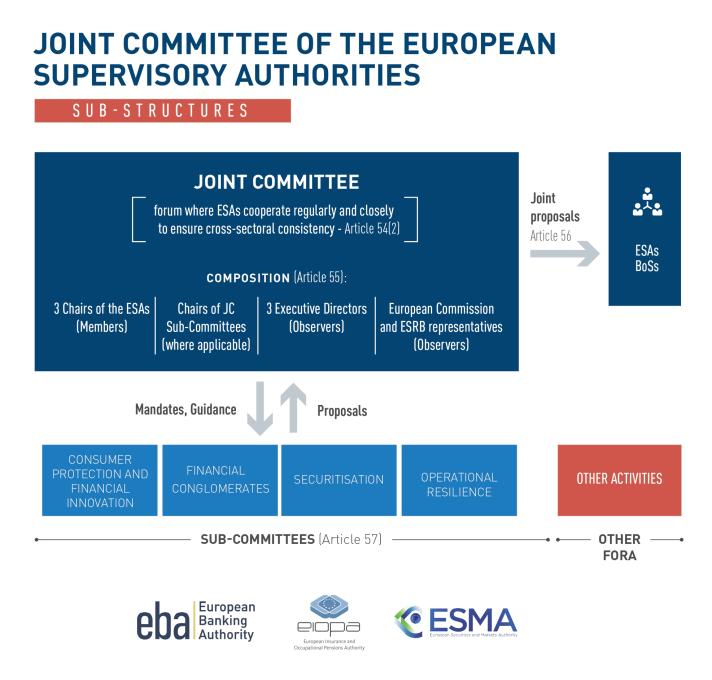About us
The Joint Committee is a forum with the objective of strengthening cooperation between the European Banking Authority (EBA), the European Insurance and Occupational Pensions Authority (EIOPA) and the European Securities and Markets Authority (ESMA), collectively known as the three European Supervisory Authorities (ESAs).
Through the Joint Committee, the three ESAs coordinate their supervisory activities in the scope of their respective responsibilities regularly and closely and ensure consistency in their practices. In particular, the Joint Committee works in the areas of micro-prudential analyses of cross-sectoral developments, risks and vulnerabilities for financial stability, retail financial services and consumer and investor protection issues and retail investment products, cybersecurity, financial conglomerates, accounting and auditing.. The ESAs, within the Joint Committee, jointly explore and monitor potential emerging risks for financial markets participants and the financial system as a whole.
The Joint Committee has a dedicated staff provided by each of the ESAs that acts as a secretariat.
In addition to being a forum for cooperation, the Joint Committee plays an important role in the exchange of information with the European Systemic Risk Board (ESRB) and in developing the relationship between the ESRB and the ESAs.

You can find further information about the three ESAs on their respective websites:
Composition
The Joint Committee is composed of:
- the Chairpersons of the ESAs, and, where applicable, the Chairperson of any Joint Committee Sub-Committee
- Observers
- the Executive Directors of the ESAs;
- a representative of the Commission; and
- a representative of the ESRB.
Chairing Authority
The Chairperson of the Joint Committee is appointed on an annual rotational basis from among the Chairpersons of the ESAs. The Chairperson of the Joint Committee shall be a Vice-Chair of the ESRB.
The respective ESA chairing the Joint Committee is responsible for coordinating the work on a number of recurring and other, one-off topics, that may emerge in the different cross-sectoral areas. It organises quarterly Joint Committee meetings or conference calls to discuss and decide on the ESAs joint work.
The chairing of the Joint Committee is as follows:
- 2024 - ESMA
- 2025 - EIOPA
Scope of activities
In its work the Joint Committee primarily addresses the following regulatory areas to ensure cross-sectoral consistency:
- financial conglomerates;
- accounting and auditing;
- micro-prudential analyses of cross-sectoral developments, risks and vulnerabilities for financial stability;
- retail investment products;
- cybersecurity;
- information and best practice exchange with the ESRB and the other ESAs;
- retail financial services and consumer and investor protection issues; and
- advice by the Committee established in accordance with Article 1(6).
Download the mandates of the subcommittees of the Joint Committee
Joint Committee Work Programme
The work programme of the Joint Committee is, like the individual work programme of each ESA, updated and published on an annual basis:
Read the Joint Committee Work Programme 2024
Read the Joint Committee Work Programme 2025
Joint Committee Annual Report
The ESAs are individually accountable to the European Parliament and the Council. The Joint Committee as the body, by which the ESAs cooperate on cross sectoral issues is accountable to the European Parliament and the Council. The Joint Committee publishes every year its annual report that is also published as an integral part of the ESAs annual reports.
Joint Committee Statement at the European Parliament
The presiding Chair of the Joint Committee of the ESAs also appears before the European Parliament to report on the ESAs’ joint work over the past year and to outline the committee’s future areas of focus.
Read the 2022 Statement of the Joint Committee Chair
Read the Annex containing the deliverables of the Joint Committee - 2022
Cross-sectoral work
The Joint Committee also undertakes work related to other cross-sectoral issues, such as the regulation of benchmarks, structured financial products (securitisation), credit rating agencies and others.
Find out more
European Forum for Innovation Facilitators (EFIF)
The EFIF provides a platform for supervisors to meet regularly to share experiences from engagement with firms through innovation facilitators (regulatory sandboxes and innovation hubs), to share technological expertise, and to reach common views on the regulatory treatment of innovative products, services and business models, overall boosting bilateral and multilateral coordination.
Library of the Joint Committee
Read the publications issued jointly by the three supervisory authorities under the Joint Committee.
Joint Committee consultations
To fulfil its commitment to openness and transparency, the Joint Committee conducts written consultations in order to receive comments from all the interested parties, including market participants, consumers and other end-users.
Check below the open and closed consultations
Joint Committee Guidelines
The three supervisory authorities issue guidelines on topics of cross-sectoral relevance.
Joint Q&As
The three European Supervisory Authorities - EBA, ESMA and EIOPA - the ESAs, develop joint Q&As to support the consistent and effective application of the EU regulatory framework for the financial services sector. These Q&As also contribute to the completion of the EU Single Rule Book.
The ESAs do this by publicly providing responses to questions asked by the public, financial market participants, competent authorities, Union institutions and other stakeholders.

